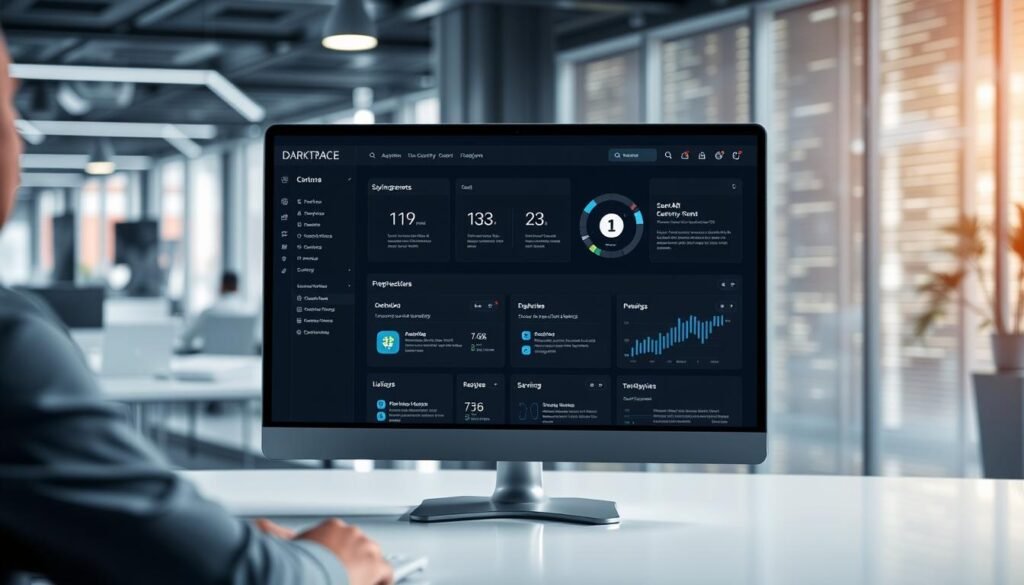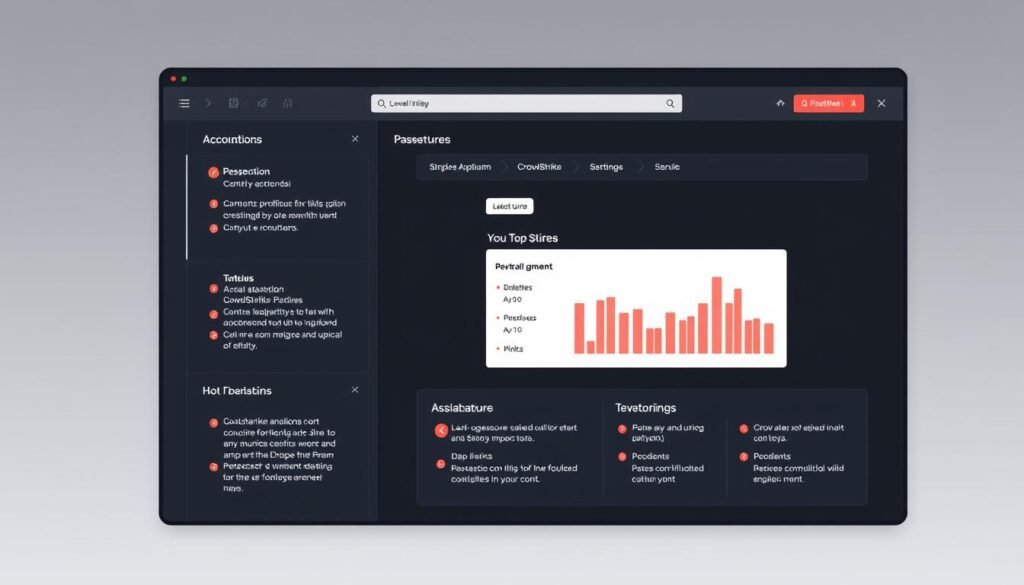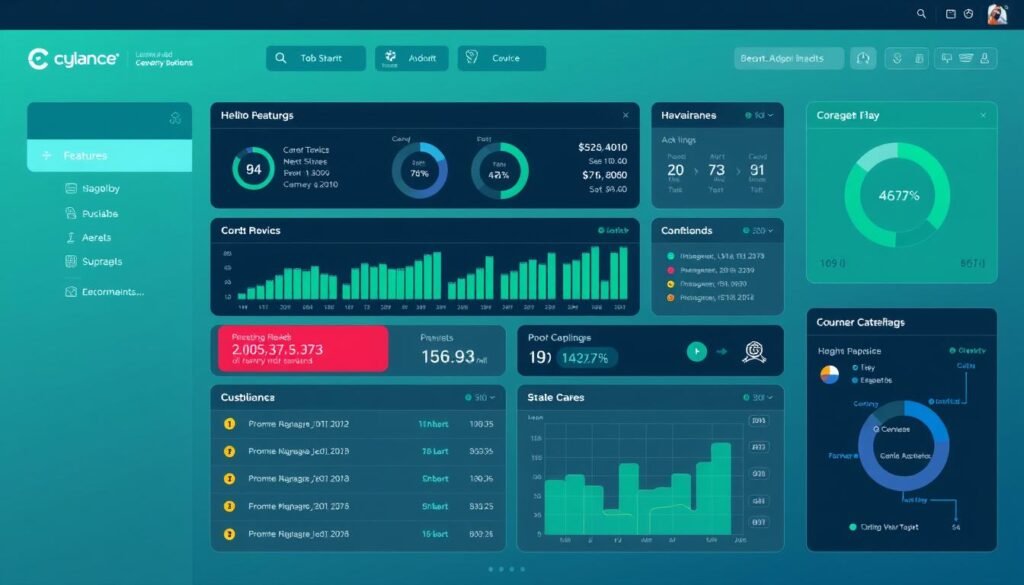As you navigate the ever-evolving digital landscape, a critical question arises: How will you stay ahead of the increasingly sophisticated cyber threats that loom over your organization’s security in 2025?
The cybersecurity landscape is rapidly changing, with machine learning and AI becoming central to both defensive and offensive security strategies. By 2025, organizations will face complex threats that traditional security measures can no longer counter effectively.
To combat these challenges, detection and response capabilities will need to be enhanced with AI-powered analysis to identify patterns and anomalies in vast amounts of data.
Key Takeaways
- The integration of machine learning in cybersecurity will transform how security teams identify and respond to potential threats.
- Organizations will need to adopt proactive security models to anticipate threats before they materialize.
- AI-powered analysis will be crucial for processing complex data to identify security patterns.
- The volume and complexity of data that security systems must process will necessitate AI-powered tools.
- Understanding emerging technologies will be crucial for safeguarding digital assets in an increasingly hostile threat landscape.
The Evolving Cybersecurity Landscape in 2025
As we approach 2025, the cybersecurity landscape is undergoing significant transformations. The increasing complexity of digital ecosystems and the rising sophistication of cyberattacks are driving the need for more advanced security measures.
Current Trends Shaping the Future of Cybersecurity
Several key trends are shaping the future of cybersecurity. The increasing sophistication of malware and attack techniques is making reactive security measures inadequate. Advanced persistent threats (APTs) are becoming more common, with state-sponsored actors and cybercriminal groups conducting long-term, stealthy campaigns that evade traditional detection methods.
Some of the significant trends include:
- The rapid exploitation of zero-day vulnerabilities, reducing the window for organizations to patch systems before attacks occur.
- The growing importance of predictive threat intelligence for identifying potential attack vectors before they’re exploited.
- The need for network security to evolve beyond signature-based detection to incorporate behavioral analysis that can identify anomalous activities indicative of new threats.
Why Proactive Protection Will Be Essential by 2025
By 2025, proactive protection will be crucial for organizations to safeguard their data and systems. The financial impact of security breaches will continue to rise, making the business case for proactive security investments more compelling than reactive incident response. Organizations that maintain a purely reactive security posture will face significantly higher risks of data breaches, ransomware attacks, and other security incidents compared to those employing proactive protection strategies.
To stay ahead, organizations will need to adopt advanced security tools and strategies that can detect and respond to malware and other threats in real-time. This includes leveraging predictive threat intelligence and incorporating analysis into their security frameworks.
The Rise of AI-Powered Cyberattacks
As we approach 2025, the cybersecurity landscape is expected to be significantly impacted by the rise of AI-powered cyberattacks. The increasing sophistication of AI technology is enabling attackers to launch more complex and targeted attacks, making it challenging for traditional security measures to detect and prevent them.
The integration of AI in cyberattacks is not only making them more potent but also more difficult to anticipate. Attackers are leveraging AI to automate tasks, improve the efficacy of their attacks, and evade detection.
How AI Is Transforming the Threat Landscape
AI is transforming the threat landscape by enabling attackers to analyze vast amounts of data to identify vulnerabilities and craft highly targeted attacks. AI-powered threat detection evasion is becoming a significant concern as attackers use AI to understand and bypass security measures.
The use of AI in cyberattacks is also leading to the development of more sophisticated malware that can adapt and evolve over time, making it harder for security systems to keep up.
Most Common AI-Powered Attack Vectors in 2025
By 2025, several AI-powered attack vectors are expected to become more prevalent. These include:
Deepfakes and Advanced Social Engineering
Deepfakes, which are AI-generated audio or video that can mimic real individuals, will be used in advanced social engineering attacks to trick victims into divulging sensitive information or performing certain actions.
AI-Driven Phishing Campaigns
AI will be used to launch highly targeted phishing campaigns that are more convincing and difficult to detect. These campaigns will use AI-generated content to personalize attacks and increase their success rate.
Adversarial Machine Learning Attacks
Adversarial machine learning attacks will target the AI models that power security systems, deliberately feeding them manipulated data to cause misclassification of threats. Some of the tactics used will include:
- Creating “poison pill” datasets that compromise security models during training.
- Designing malware to appear benign to machine learning detection systems.
- Engaging in an AI arms race, where security vendors develop defensive techniques such as adversarial training and model hardening.
To counter these threats, organizations will need to implement rigorous validation processes for their AI security models and adopt multi-model approaches that combine different machine learning techniques.

Ransomware Protection, Advanced Threat Intelligence, and Cybersecurity AI Tools in 2025
The year 2025 is poised to revolutionize cybersecurity with AI-powered solutions that enhance threat detection and response. As cyber threats become more sophisticated, the integration of AI in modern security strategies is crucial for protecting against ransomware, advanced threats, and other cyberattacks.
The Integration of AI in Modern Security Strategies
In 2025, AI will be deeply integrated into cybersecurity frameworks, enabling organizations to bolster their defenses against evolving threats. AI-powered security solutions will process vast amounts of data to identify patterns and anomalies that may indicate potential security breaches. This integration will significantly enhance the capabilities of security systems to detect and respond to threats in real-time.

Benefits of AI-Powered Security Solutions
AI-powered security solutions offer numerous benefits, including:
- Enhanced threat detection speeds, reducing the time from initial compromise to discovery from months to mere minutes or seconds.
- Improved detection of subtle connections and patterns that indicate coordinated attacks or campaigns through the analysis of vast security data.
- Dramatic reduction in false positives through machine learning algorithms that understand context and normal behavior patterns.
- Automation of immediate response to detected threats, containing incidents before they spread and cause significant damage.
- Predictive capabilities that allow organizations to anticipate and prepare for emerging threats based on early warning signals.
- Continuous adaptation to evolving threats, improving future detection capabilities without manual updates.
- Scalability across expanding digital environments, including cloud services, IoT devices, and remote work infrastructure.
- Cost efficiencies through reduced incident impact and more effective allocation of security resources.
By leveraging these AI-powered security solutions, organizations can significantly enhance their cybersecurity posture in 2025, protecting against a wide range of threats and minimizing potential damage.
Top AI-Powered Cybersecurity Tools for 2025
With the evolving threat landscape, AI-powered cybersecurity tools are becoming essential for organizations in 2025. As cyber threats become more sophisticated, the need for advanced security solutions that can detect, respond, and prevent attacks is critical.
Microsoft Security Copilot

Overview
Microsoft Security Copilot is an AI-powered cybersecurity tool designed to enhance an organization’s security posture. It provides real-time threat detection and response capabilities, leveraging Microsoft’s vast security data and AI expertise.
Pros
Enhanced Threat Detection: Utilizes AI to identify and respond to threats more effectively.
Real-time Response: Enables swift action against detected threats, minimizing potential damage.
Cons
Dependency on Microsoft Ecosystem: Optimal performance may require integration with other Microsoft security tools.
Complexity: May require specialized knowledge to fully leverage its capabilities.
Key Features
AI-driven Threat Detection: Analyzes vast amounts of data to identify potential threats.
Automated Response: Enables quick response to detected threats, reducing the risk of significant breaches.
Darktrace ActiveAI Security Platform

Overview
Darktrace’s ActiveAI Security Platform uses AI to detect and respond to cyber threats in real-time. It provides continuous monitoring and anomaly detection across the network, endpoints, and cloud environments.
Pros
Real-time Threat Detection: Identifies and responds to threats as they emerge.
Comprehensive Coverage: Monitors across various environments, including network, endpoints, and cloud.
Cons
Potential for False Positives: AI-driven systems can sometimes flag benign activities as threats.
Resource Intensive: Requires significant resources for implementation and management.
Key Features
AI-driven Anomaly Detection: Identifies unusual patterns that may indicate a threat.
Automated Response Capabilities: Enables swift action against detected threats.
SentinelOne Singularity Platform

Overview
SentinelOne’s Singularity Platform is an AI-powered cybersecurity solution that provides endpoint protection, detection, and response. It uses AI to prevent, detect, and respond to threats in real-time.
Pros
Comprehensive Endpoint Protection: Covers a wide range of endpoint devices.
AI-driven Prevention: Uses AI to prevent known and unknown threats.
Cons
Complexity in Management: Requires expertise to manage and configure effectively.
Cost: Can be expensive, especially for large organizations.
Key Features
AI-powered Prevention: Blocks threats before they can cause harm.
Real-time Detection and Response: Identifies and responds to threats as they occur.
CrowdStrike Falcon Platform

Overview
CrowdStrike’s Falcon Platform is a cloud-native cybersecurity solution that uses AI to detect and prevent threats. It provides real-time visibility across the enterprise, enabling swift threat detection and response.
Pros
Cloud-native Architecture: Scalable and flexible, suitable for cloud environments.
Real-time Threat Intelligence: Provides up-to-date information on emerging threats.
Cons
Dependence on Cloud Connectivity: Requires stable cloud connectivity for optimal performance.
Learning Curve: May require training to fully utilize its features.
Key Features
AI-driven Threat Detection: Identifies threats using advanced AI algorithms.
Real-time Response: Enables immediate action against detected threats.
Cylance AI Security Solutions

Overview
Cylance AI Security Solutions utilize AI to prevent, detect, and respond to cybersecurity threats. The solution focuses on predictive threat prevention, reducing the risk of breaches.
Pros
Predictive Prevention: Uses AI to predict and prevent potential threats.
Low False Positive Rate: AI-driven analysis helps in reducing false positives.
Cons
Initial Setup Complexity: May require significant setup and configuration.
Resource Requirements: Needs adequate resources for effective operation.
Key Features
AI-driven Predictive Prevention: Anticipates and prevents threats before they materialize.
Continuous Monitoring: Provides ongoing monitoring and threat detection.
Vectra AI Platform

Overview
Vectra’s AI Platform is designed to detect and respond to cyberattacks in real-time. It uses AI to analyze network traffic and identify potential threats, providing actionable insights.
Pros
Real-time Threat Detection: Identifies threats as they occur, enabling swift response.
AI-driven Analysis: Provides deep insights into detected threats.
Cons
Integration Complexity: May require integration with existing security tools.
Cost Considerations: Pricing may be a factor for some organizations.
Key Features
Advanced Identity-based Attack Detection: Identifies compromised credentials and unauthorized access attempts.
AI-driven Entity Scoring: Continuously assesses the risk level of users, devices, and applications.
Vectra’s threat intelligence integration provides context for detected attacks, including attribution to known threat actors and tactical recommendations for strengthening defenses. The solution offers automated response capabilities through integrations with firewalls, NAC solutions, and EDR platforms, enabling immediate containment of compromised assets. Additionally, Vectra’s detection models are customizable for specific industry threats and compliance requirements, making the platform more effective for organizations in highly regulated sectors.
Advanced Threat Intelligence Platforms for 2025
With cyber threats becoming increasingly complex, the importance of advanced threat intelligence platforms in 2025 cannot be overstated. As organizations strive to protect their digital assets, these platforms will play a critical role in enhancing their cybersecurity posture.
The Evolution of Threat Intelligence
The landscape of threat intelligence is undergoing a significant transformation. Traditional threat intelligence methods are being replaced by more advanced, AI-driven solutions that can analyze vast amounts of data from diverse sources. This evolution is driven by the need for more accurate and timely threat detection.
Key developments in threat intelligence include:
- Automated collection and analysis of data from thousands of sources
- Use of natural language processing to extract insights from unstructured text
- Attribution capabilities to identify threat actors and their motivations
Key Capabilities of Next-Generation Threat Intelligence
Next-generation threat intelligence platforms will offer several key capabilities that will enhance an organization’s ability to detect and respond to threats. These include:
- Advanced correlation engines to reveal coordinated attack campaigns
- Customizable risk scoring based on an organization’s specific vulnerabilities
- Integration with vulnerability management tools for prioritized patching
- Actionable playbooks for effective threat response
- Predictive analytics to identify potential attack vectors
By leveraging these capabilities, organizations can significantly improve their cybersecurity defenses and stay ahead of emerging threats.
Emerging Technologies in Malware Analysis and Detection
Emerging technologies are revolutionizing the field of malware analysis and detection, offering more robust security solutions. As cyber threats become increasingly sophisticated, the need for advanced detection methods has never been more critical.
Machine Learning for Zero-Day Threat Detection
Machine learning is being increasingly utilized for zero-day threat detection. By analyzing patterns in data, machine learning algorithms can identify potential threats that traditional security measures might miss. This proactive approach enables organizations to stay ahead of emerging malware threats.
Behavioral Analysis and Anomaly Detection
Behavioral analysis and anomaly detection are becoming cornerstone technologies for identifying sophisticated threats. By monitoring activity across the network and system, these technologies can detect deviations from established patterns that may indicate malicious activity. Advanced behavioral analysis systems leverage contextual analysis to reduce false positives, distinguishing between unusual but legitimate activities and genuinely suspicious behaviors.
- Detecting deviations in user, device, application, and network segment behavior.
- Extending detection beyond endpoint monitoring to cloud services and identity systems.
- Utilizing unsupervised machine learning to identify clusters of related malicious behaviors.
How to Choose the Right Cybersecurity Tools for Your Organization
The effectiveness of your cybersecurity strategy hinges on selecting the right tools that align with your organization’s security requirements. As cyber threats continue to evolve, it’s crucial to assess your security needs and identify the most suitable tools to address them.
Assessing Your Security Needs and Gaps
To choose the right cybersecurity tools, you must first understand your organization’s specific security needs and gaps. This involves conducting a thorough risk assessment to identify potential vulnerabilities and threats. Consider the types of data you need to protect, the regulatory requirements you must comply with, and the current security measures you have in place.
- Evaluate your existing security infrastructure and identify areas for improvement.
- Consider the types of threats your organization is most likely to face.
- Assess the level of security expertise within your organization.
Integration Considerations for Maximum Protection
When selecting cybersecurity tools, it’s essential to consider their ability to integrate with your existing security infrastructure. Tools that offer robust API capabilities and pre-built integrations can help create a cohesive defense ecosystem.
- Prioritize tools that support industry standards like STIX/TAXII for threat intelligence sharing.
- Assess the total cost of integration, including licensing, professional services, and maintenance.
- Evaluate vendor partnership ecosystems to determine their potential for collaborative development.
By carefully assessing your security needs and considering integration capabilities, you can choose cybersecurity tools that provide comprehensive protection for your organization.
Conclusion: Preparing Your Digital Security Strategy for 2025
With 2025 approaching, organizations must prioritize a proactive cybersecurity posture to stay ahead of emerging threats. This involves leveraging AI and machine learning to enhance detection and response capabilities. The convergence of advanced threat intelligence, behavioral analysis, and automated response will be crucial in defending against sophisticated attacks, including AI-powered threats.
To achieve effective cybersecurity, organizations should invest in tools that provide comprehensive visibility across all digital assets and develop a balanced approach that combines preventive controls, detection capabilities, and response automation. Regular assessment of security capabilities and ongoing investment in security awareness and training will also be essential.
By embracing these principles, organizations can build a robust digital security strategy that protects critical assets and enables confident innovation.



